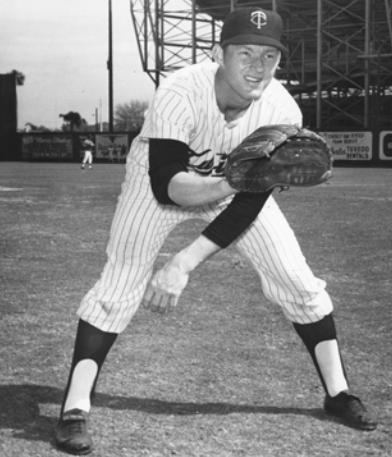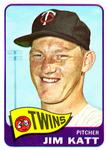July 30, 1971: Quiet as kittens against Kaat, Yankees roar back to beat Twins
 Jim Kaat knew how to win ballgames. In 1971 Kaat would win at least 10 games for the 10th straight year. From 1964 to 1970, he won 35 more games than he lost. The Twins had taken the first two American League West titles in 1969 and 1970 but struggled in 1971, falling out of first place on April 14 and never returning to the top spot. Pitching made the difference. Minnesota had the second best earned-run average in the AL in 1970 and the second worst in 1971.
Jim Kaat knew how to win ballgames. In 1971 Kaat would win at least 10 games for the 10th straight year. From 1964 to 1970, he won 35 more games than he lost. The Twins had taken the first two American League West titles in 1969 and 1970 but struggled in 1971, falling out of first place on April 14 and never returning to the top spot. Pitching made the difference. Minnesota had the second best earned-run average in the AL in 1970 and the second worst in 1971.
Before taking on the Yankees on July 30, Kaat had won consecutive 2-1 victories against New York and Boston. He had yielded just 10 hits in his two complete games. A Twin Cities sportswriter explained Kaat’s secret: “He had four of the staff’s five previous complete games and said some of his success was due to a new pitch, a screwball.”1
Expectations of a third straight close-fought win with Kaat on the hill did not come to fruition on July 30 at the Met. On this day, Minnesota fans would seemingly enjoy a rout … and a trout, as the team put on a fishing-related promotion in the Land of 10,000 Lakes.
The Minnesota beat writer opened his game recap with a quip befitting both his name and the occasion. As Jon Roe wrote, “The 20 trout caught out of a tank at Fisherman’s night at Metropolitan Stadium got off easy. … There were 19,233 fans who got hooked, too. What those fans watched should have made the Twins want to dive in with the trout.”2
After Kaat set down the Yanks in order in the top of the first, the Twins laced Stan Bahnsen early and often. Cesar Tovar had an infield single and scored on when Bahnsen made a wild throw on Rod Carew’s bunt single. The miscue was something Bahnsen’s more accomplished mound counterpart rarely committed. (Kaat won the American League Gold Glove Award for pitchers every year from 1962 to 1973.) Minnesota had manufactured an early run without the ball leaving the infield. Then Harmon Killebrew walked and Tony Oliva doubled in both of his future Hall of Fame teammates. With three runs on the board, none out, and a runner in scoring position, Kaat must have felt grateful for the unaccustomed run support. While Oliva did not score, the Twins led 3-0 after one.
The Twins helped New York get back into the game in the top of the second. With one out, Kaat walked Danny Cater. Kaat dialed up a grounder on a Ron Swoboda comebacker, but Leo Cardenas muffed the throw, putting runners at first and second. Horace Clarke singled in Cater to cut the lead to 3-1, a score that stood until the bottom of the fifth.
In this game Kaat may have expended more energy on offense than on defense. In the bottom of the second inning, he walked and stole second base, his second swipe of the year (tying the career high he set in 1965). In the fifth he legged out a double off Yankees reliever Al Closter.
After a quiet few innings, the Twins exploded for six runs in the bottom of the fifth on a rally that again started with an infield single by Tovar followed by a bunt single by Carew. Bahnsen wild-pitched the two speedy troublemakers to second and third. This time, he retired Killebrew, then walked Oliva intentionally to set up a double play. The stratagem for the Yankees blew up when the next three Twins had productive at-bats. Rich Reese singled in Tovar and Carew to give the Twins a 5-1 lead. Cardenas likewise singled to load the bases. Jim Nettles hit a sacrifice fly to put Minnesota up 6-1. George Mitterwald delivered what must have felt like a knockout blow with a three-run homer that gave the Twins a 9-1 edge and ended Bahnsen’s bad day on the mound. Al Closter came on for Bahnsen. Kaat greeted the new pitcher with a double and Tovar reached on an error, but neither scored when Carew struck out.
Kaat relaxed, weakened, or both in the top of the sixth. Cater homered with one out to get New York a run closer at 9-2. With two outs, the Yanks scratched out an additional run on singles by John Ellis, Clarke, and Ron Hansen, who had pinch-hit for Closter. Still, Minnesota had a substantial six-run lead after 5½ innings.
The Twins could not tack anything on against the back end of the New York bullpen as Roger Hambright got through the home half of the sixth unscathed.
Bill Rigney, “the manager who had gained fame, and perhaps fortune, by manipulating relief pitchers,”3 started to lift his regulars with Minnesota up by six runs. Jim Holt came in for Oliva, and, after Thurman Munson doubled to start the seventh, Ray Corbin relieved Kaat. Having waived the struggling Ron Perranoski to Detroit earlier in the day, Minnesota had one less veteran relief pitcher. Facing Corbin, Felipe Alou singled in Munson, but the Twins went into the stretch still up by five.
In the bottom of the seventh, shortstop Gene Michael’s second error of the game and Munson’s passed ball put a runner in scoring position. Feeling no need to extend his lead or tax his bullpen, Rigney let Corbin hit. The reliever struck out. Minnesota led 9-4 with just two innings to go.
Corbin quickly made Rigney regret his passivity by walking the bases loaded in the eighth. Stan Williams came in and walked Munson, forcing in a run. Down 9-5 but with the bases loaded and none out, the Yanks brought the tying run to the plate. Alou popped out, but Williams threw a wild pitch and then walked Roy White, so New York still had the bases loaded and now trailed 9-6 with the tying run at first. In the midst of a big day at the plate, Cater came through with a clutch bases-clearing double, the only hit and the only ball that left the infield during the five-run inning, to tie the score, 9-9. Managing aggressively now, Rigney yanked Williams and brought in Tom Hall, his best arm out of the bullpen. Hall threw a wild pitch, but Cater did not advance beyond third.
Following Rigney’s lead, Yankee manager Ralph Houk turned to his best reliever in the eighth, Jack Aker. Minnesota went back to its bread-and-butter offensive attack. Tovar got his third infield single of the game, and Carew bunted again. This time the Yankees retired Carew, who received credit for a sacrifice. Aker retired Killebrew and then had the easier task of facing Holt (who hit .259 in 1971) rather than Oliva (the eventual batting champion at .337). Aker got Holt on a fly ball and held the score at 9-9.
The Yankees played small ball to take the lead for the first time in the ninth inning. Clarke walked and Aker sacrificed him to second. Michael’s single scored Clarke, breaking the tie, and Munson doubled in Michael. As Murray Chass of the New York Times opined, “Michael’s hit was particularly gratifying . . . because the shortstop had been in a hitting and fielding slump. Including two errors he made [against the Twins], Michael had committed five in the last seven games. He had a total of only eight in all the others. At bat in the three previous games he had struck out seven times in eight trips.”4
With New York leading 11-9, Aker stayed on to try to close the game. With two outs and none on, the Twins rallied. Nettles walked and Mitterwald singled. Pinch-hitter Steve Braun rolled one to Cater at first. In a fitting conclusion by the star of the game, Cater made the play himself, cementing the improbable comeback win by the Yankees, a feat made all the more improbable by its genesis against an accomplished pitcher like Jim Kaat.
Notes
1 Bob Fowler, “Circus Act by Twins – But Rig’s Not Laughing,” The Sporting News, August 14, 1971: 29.
2 Jon Roe, “Twins, After Leading 9-1, Get ‘Hooked’ by Yankees 11-9,” Minneapolis Tribune, July 31, 1971: 1B.
3 Bob Fowler, “Twins’ Tortured Staff Due for a Major Overhaul,” The Sporting News, August 21, 1971: 21.
[4] Murray Chass, “Yanks Win, 11-9, From Twins,” New York Times, July 31, 1971: 17.
Additional Stats
New York Yankees 11
Minnesota Twins 9
Metropolitan Stadium
Bloomington, MN
Box Score + PBP:
Corrections? Additions?
If you can help us improve this game story, contact us.


